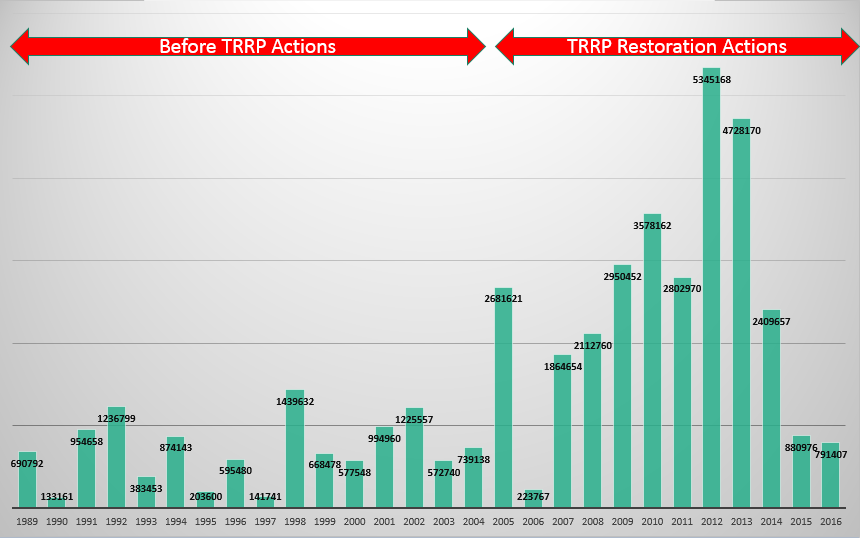POPULATION ESTIMATES
It is natural for salmon populations to vary dramatically from year to year, reflecting variations in freshwater and marine conditions, and the adult harvest levels.
The Trinity River juvenile salmonid outmigrant assessment is conducted to assess juvenile Chinook salmon production from the upper 40 miles and the Trinity Basin to estimate salmon and steelhead emigration timing from the Trinity River basin.
Assessments utilize rotary screw traps at two trapping locations, typically monitored from January through August. The upper trap location – at Pear Tree Gulch, just above the North Fork – provides an estimate of the upper Trinity salmonid production. Meanwhile the lower trap location – just below the town of Willow Creek – provides an estimate for production across the entire Trinity River basin.
Outmigrant monitoring also tracks fish growth, health, and timing of outmigration relative to river temperature and flow rate.
Rotary Screw Traps
Juvenile salmonid outmigrant assessments are conducted annually at two sampling sites along the Trinity River: the Pear Tree and Willow Creek rotary screw trap sites. The Pear Tree site is located within the 40-mile Trinity River restoration reach at a distance of 38.7 miles downstream of Lewiston dam. The Willow Creek site is located 21.1 miles upstream from the Trinity River confluence with the Klamath River.
Rotary screw traps are operated at both sites to estimate juvenile Chinook salmon populations, emigration timing, fish size, and condition responses to restoration actions, including habitat restoration, flow releases, and temperature management. Results from the Pear Tree site are used to assess the overall effectiveness of the TRRP in restoring fish production in the restoration reach. Results from the Willow Creek site provides estimates of overall fish production in the Trinity River and its tributaries above this location.
Juvenile salmonid population increasing
Although we have yet to see a clear change in the numbers of salmon that survive conditions and harvest in the Klamath River and Pacific Ocean, it is now clear that the number of young fish leaving the Trinity River has increased since establishment of the ROD.
JUVENILE DISEASE
Fish disease outbreaks in the Lower Klamath River may have a detrimental effect on out migrating juvenile Trinity River salmon and steelhead. The California-Nevada Fish Health Center examines juvenile Klamath River Chinook salmon for the incidence of two infectious diseases caused by parasites. From April 20 through August 10, 2009, Ceratomyxa shasta was detected in 45 percent (489/1090) and Parvicapsula minibicornis was detected in 80 percent (873/1090) of Klamath Chinook juveniles tested. Detection of disease organisms does not necessarily mean the fish will succumb to the disease.
For updates, please visit http://www.fws.gov/arcata/fisheries/projectUpdates.html#fishHealth

